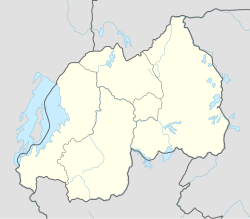
The United Nations Assistance Mission for Rwanda (UNAMIR) was established by United Nations Security Council Resolution 872 on 5 October 1993. It was intended to assist in the implementation of the Arusha Accords, signed on 4 August 1993, which was meant to end the Rwandan Civil War. The mission lasted from October 1993 to March 1996. Its activities were meant to aid the peace process between the Hutu-dominated Rwandese government and the Tutsi-dominated rebel Rwandan Patriotic Front (RPF). The UNAMIR has received much attention for its role in failing, due to the limitations of its rules of engagement, to prevent the Rwandan genocide and outbreak of fighting. Its mandate extended past the RPF overthrow of the government and into the Great Lakes refugee crisis. The mission is thus regarded as a major failure.

The Rwandan genocide occurred between 7 April and 15 July 1994 during the Rwandan Civil War. During this period of around 100 days, members of the Tutsi minority ethnic group, as well as some moderate Hutu and Twa, were killed by armed Hutu militias. Although the Constitution of Rwanda states that more than 1 million people perished in the genocide, the real number killed is likely lower. The most widely accepted scholarly estimates are around 500,000 to 800,000 Tutsi deaths.
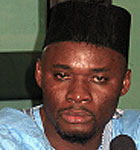
Hassan Ngeze is a Rwandan journalist and convicted war criminal best known for spreading anti-Tutsi propaganda and Hutu superiority through his newspaper, Kangura, which he founded in 1990. Ngeze was a founding member and leadership figure in the Coalition for the Defence of the Republic (CDR), a Rwandan Hutu Power political party that is known for helping to incite the genocide.

Kangura was a Kinyarwanda and French-language magazine in Rwanda that served to stoke ethnic hatred in the run-up to the Rwandan genocide. The magazine was established in 1990, following the invasion of the rebel Rwandan Patriotic Front (RPF), and continued publishing up to the genocide. Edited by Hassan Ngeze, the magazine was a response to the RPF-sponsored Kanguka, adopting a similar informal style. "Kangura" was a Rwandan word meaning "wake others up", as opposed to "Kanguka", which meant "wake up". The journal was based in Gisenyi.
The Apostolic Vicariate of Kivu can refer to either of two vicariates of the White Fathers, a Catholic missionary society in the Latin Church of the Catholic Church. Both vicariates served lands around Lake Kivu during the early to mid 20th century. The first vicariate, from 1912 to 1922, served what are now Rwanda and Burundi. The second vicariate, from 1929 to 1952, served territory in the east of the Belgian Congo.
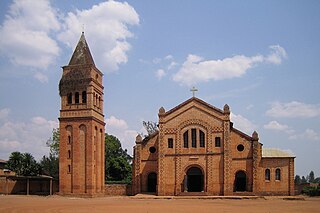
Christianity is the largest religion in Rwanda. The most recent national census from 2012 indicates that: 43.7% of Rwanda's population is Catholic, 37.7% is Protestant, 11.8% is Seventh-day Adventist, 2.0% is Muslim, 2.5% claims no religious affiliation, and 0.7% is Jehovah's Witness.
The Apostolic Vicariate of Southern Nyanza was a Roman Catholic mission territory in Eastern and Central Africa. It was an apostolic vicariate split out from the larger Vicariate of Nyanza in June 1894. It lost territory to the Apostolic Vicariate of Kivu in 1912, and was divided into the vicariates of Bukoba and Mwanza in 1929.
The Rwandan Revolution, also known as the Hutu Revolution, Social Revolution, or Wind of Destruction, was a period of ethnic violence in Rwanda from 1959 to 1961 between the Hutu and the Tutsi, two of the three ethnic groups in Rwanda. The revolution saw the country transition from a Tutsi monarchy under Belgian colonial authority to an independent Hutu-dominated republic.
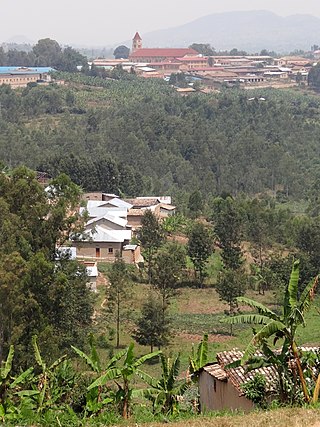
Kabgayi is just south of Gitarama in Muhanga District, Southern Province, Rwanda, 25 miles (40 km) southwest of Kigali. It was established as a Catholic Church mission in 1905. It became the center for the Roman Catholic Church in Rwanda and is the site of the oldest cathedral in the country and of Catholic seminaries, schools and a hospital. The church at first supported the Tutsi ruling elite, but later backed the Hutu majority. During the 1994 Rwandan genocide thousands of Tutsis who had taken refuge here were killed. Some survivors admire the courage of many priests who helped them during those difficult days, like Father Evergiste RUKEBESHA and many others. Later, some Hutus including three bishops and many priests were killed by the rebels RPF soldiers. A mass grave beside the hospital is marked by a memorial. Inside the Basilica are kept the bodies of the three bishops killed by FPR rebels. Two of them were refused by the Rwandan government to be transferred in their own cathedrals.

Archbishop André Perraudin, M. Afr. was a Swiss Catholic clergyman who lived in Rwanda for nearly fifty years. He was Archbishop of Kabgayi from 1959 to 1989.
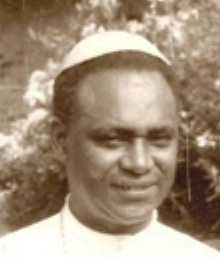
Aloys Bigirumwami was a Rwandan prelate of the Roman Catholic Church. He served as Bishop of Nyundo from 1959 to 1973, having previously served as its apostolic vicar.
Zaza is a community in Rwanda to the east of Lake Mugesera and about 10 miles (16 km) west of Kibungo. It is in the Ngoma District of the Eastern Province of Rwanda.
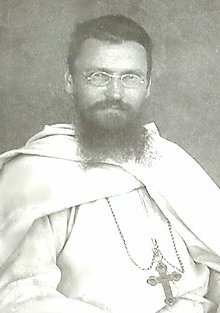
John Joseph Hirth was a Catholic bishop in German East Africa, known as the founder of the church in Rwanda.
The Sebeya River is a river in Western Province, Rwanda that empties into Lake Kivu just south of the town of Gisenyi.
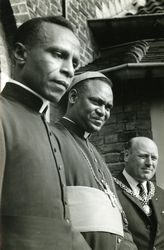
Wenceslas Kalibushi was a Rwandan Catholic bishop.
Save is one of the first Catholic missions in Rwanda. It is a few miles north of the town of Butare, and in the west of the Gisagara District of Southern Province, Rwanda. There is a church, several schools and a health centre. It is also home to the Mother House of the Benebikira Sisters.

Léon-Paul Classe, M.Afr. was a Catholic priest who was Vicar Apostolic of the Apostolic Vicariate of Ruanda, in what is now Rwanda, from 1922 until his death in 1945. During his time as a missionary priest and then bishop a great many Rwandans were converted to Christianity. Classe was influential in persuading the Belgian colonial administration to favor the Tutsis as a ruling caste in the country over the Hutu majority.
Laurent-François Déprimoz, M. Afr. was a Catholic priest who was Vicar Apostolic of the Apostolic Vicariate of Ruanda and then of the Apostolic Vicariate of Kabgayi.
Félicité Niyitegeka was a Rwandan Roman Catholic nun in charge of Centre Saint Pierre in Gisenyi town, in the Western Province. She was born in 1934 to Simon Sekabwa and Angelina Nyirampabuka. She was killed on 21 April 1994 during the genocide against the Tutsi. Those close to her nicknamed her 'ikimanuka' as a result of her likable personality and integrity.

